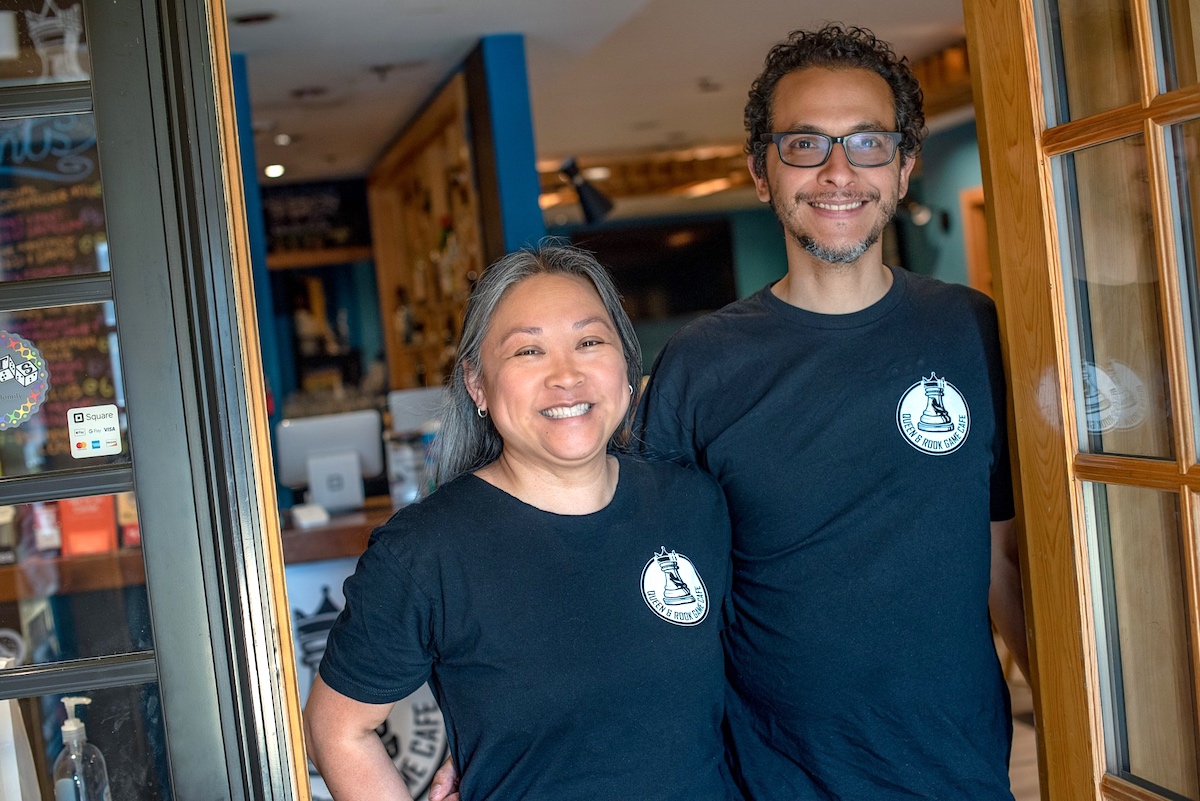The COVID-19 pandemic has rocked the way we work.
In addition to the millions who lost their jobs entirely, droves of Americans left their shared workspaces in March, or headed to their essential jobs with a pared-down staff and a lot of questions. Many working women across America, and here in Philadelphia, prepped to spend the next few weeks at home with partners, children, and maybe extended families or roommates. They scheduled calls around kids’ virtual learning, made a plan for childcare with their next-door neighbor or grandparents, and hunkered down for a short stint of a nonexistent work-life balance.
A week or so in, the cracks started to show. Parents were paying for daycare their kids couldn’t attend and leaning on extra family members for help. They were scheduling every second of their days, from meal-prepping to extra screen time to cope, some told Technical.ly in mid-March.
Ten months later, those cracks have become valleys. Especially for women.
Millions of Americans have dropped out of the workforce this year, but a recent study from the Center for American Progress shows that it’s overwhelmingly women who are losing their jobs. In September alone, the report shows, four times as many women (865,000) as men (216,000) were laid off or voluntarily left their jobs.
Childcare and care for other family members was an often-cited issue. Families that used to send their children to daycare or school now had to operate everything in-house, and the Center estimates that there were roughly 9.7 million working mothers with a child under the age of 6 in 2019 before COVID-19 hit the U.S.
This pandemic has upended women's work lives, or made them consider what exactly constitutes what is or isn't work.
If families are grappling with how to handle it all, they may consider the option of the lower-earning parent to take time off work to facilitate care or schooling. More often than not (thanks to the persistent national pay gap), this falls to women. And it could mean major losses in earnings over their lifetimes, per the Center.
“Even as small a shift as 1% of mothers leaving the workforce would result in an estimated $8.7 billion economic hit to working families,” the report showed. “Only 1% of full-time working mothers shifting from full-time to part-time work would mean an estimated $5 billion less in wages per year, which doesn’t take into account the value of lost benefits such as paid leave and health insurance.”
This doesn’t even account for the specific challenges of women of color, who are feeling the effects of job loss and unemployment at disproportionate rates, the study shows. And many are essential workers, for which infrastructure during this time doesn’t provide many pathways to childcare.
Before this year, mothers had been increasingly entering the workforce, but even a 5% decline during this disruption to our lives could undo 25 years of progress, the Center found.
So, how is this dilemma playing out locally? Technical.ly spoke to 10 women in the region who are in varying stages of their careers and being forced to make decisions about their work and family lives. Some are juggling childcare while both parents work, or have left jobs to manage kids’ care or to address mental health issues. Others were forced out in furloughs or layoffs.
Most of them agreed: This pandemic has upended their work lives, or made them consider what exactly constitutes what is or isn’t work.
###
Increasingly, women are left to grapple with this dynamic: Do I work to put my kids in childcare right now — in a pandemic — or cut costs by becoming their full-time caretaker?
Freelance design researcher and UX designer Ilyssa Kyu, who also ran Amble, a sabbatical travel company, was coming off of a three-month maternity leave with her second child when the pandemic hit the Philadelphia region.
While Amble is on a hiatus until it’s safe to travel, Kyu’s applying for part-time and full-time opportunities, feeling like she needs to provide income for her family.
“But we don’t currently have child care lined up for when/if I do land something — a ‘figure it out when we get there’ approach,” she said. “Daycare is not an option for us so we’ve been searching for a nanny that’s practicing social distancing and taking the same precautions as us, but it feels like we’re searching for a unicorn.”
While she values the extra time with her daughters, being a stay-at-home mom isn’t a role she imagined doing. But it feels like the only option right now, Kyu said.
“I need childcare to find work, and I need work to pay for childcare,” she continued. “And really, both feel impossible right now.”
Erin Mooney, the former full-time communications director for the Nature Conservancy in Pennsylvania and Delaware, is also finding herself as a primary caretaker for her kids after being laid off in June. It’s a position she didn’t think she’d be in at the start of the pandemic, she said. She and her husband both worked full time and weren’t considering cutting back hours, despite the obvious challenges of working, schooling and an infinite amount of video calls happening under her roof.
But after budget cuts in April, one June morning, she logged in for work and was told her role was being eliminated.
“At 9 a.m., I had a job, and at 9:05 I did not,” she recalled in November. “It’s an experience like millions of other Americans have had, and it’s taken months to recognize that.”

Erin Mooney and her kids Anna Barsanti, 6, and Pierce Barsanti, 8. (Courtesy photo)
Mooney recognizes her level of privilege, she said. Her kids were still attending some in-person instruction as of last month and they’ll have live-in childcare through the end of the year. They still have health insurance, although it’s costing exponentially more on her husband’s plan. And the family has stayed healthy.
But it’s taken a psychological toll, she said. Mooney spent months, like many Americans, tracking down unemployment payments. And she’s taking some contract work while she figures out what the future of her professional life looks like. After about five months of unemployment, she said she’s not yet willing to take a huge pay cut — “but maybe in six months.”
“I’ve been really repeating to myself, you know, it’s only a year of your career, you’re not alone, there are way more people worse off than you are,” Mooney said. “But it’s all true. I’ve thought about my 401k. There are real effects of this that will be felt for a long time, for anyone who’s been out of work.”
Last month, on Technical.ly’s Off the Sidelines podcast, investors Jenny Abramson of Rethink Impact and Amy Griffin of G9 Ventures addressed this facet of how the pandemic is affecting working women. Full-time work is already hard for mothers, and there’s the potential loss of income, but what else is at stake?
“Since the pandemic hit, women are really stepping out to have to take care of their children, and once again, we’re the ones that are expected to stay home in households where both parents are working, which sets up a dynamic where women are not getting pay increases, they’re not getting promotions,” Griffin said. “They’ve already taken a hit once by being out of the conference rooms and on business trips for maternity leave, and now, they’re stepping away again to be with their children, as teachers and caregivers.”
The one upside, Abramson added, is that she believes the pandemic’s forced work-from-home setup has shown that there aren’t excuses for not accepting flexibility in workplaces anymore.
“I think the pandemic has taught us that there’s a lot of people who didn’t have an incentive to want to learn to use Zoom, to want to learn to work in other ways, whereas it can actually be more efficient” she said. “In the end, we’re seeing this sad downward trend of women leaving right now, but I think we might see a rebound.”
Stef Arck-Baynes, who started working as the director of communications and marketing for Benefits Data Trust early in the pandemic, is in a unique position. When she started her job in April, her husband, who owns a food truck, became their 3-year-old daughter’s primary caregiver. They sent her to daycare for a stint this summer, but with cases spiking in November, they were reconsidering that plan.

Stef Arck-Baynes and her daughter, Zoey. (Courtesy photo)
Arck-Baynes spent time in the spring wrestling with making a good impression at a new job while also fulfilling the needs of her energetic toddler.
“In the first three weeks we created a workspace in the bedroom and I kind of hid. But Zoey would pop up, wanting to be held, wanting to come play,” Arck-Baynes said. “She was fun in Zooms, she’d say hilarious things like she does, but with a new job, I’m trying to make this good first impression and I’m wondering, frankly, how do I hide my child? How do I compartmentalize my life?’”
It became clear that isn’t possible, she said, and supportive managers and coworkers have allowed some flexibility with scheduling and work-life balance. Arck-Baynes is ultimately teaching her daughter that it’s a good thing that mom works, and is hopeful that this experience will normalize having a life outside of work.
###
Some working women are in households where both partners have retained their jobs, but for many, the pandemic is heightening the gendered differences that play into work and running their lives.
“We love our jobs, we’ve been really fortunate in our professional spaces, people have been great, we have great bosses. We are for sure, one of the lucky families for a lot of reasons,” Eliza Pollack said last month. “But no matter what — and I’ve had this conversation with so many women — no matter how great our partners and bosses are, COVID has surfaced some very, very deep-seeded societal and biological differences in how we view that balance of work and childcare.”
I reached out to Pollack, who’s the City of Philadelphia’s director of innovation, after watching her share her experience as a working mom on Twitter for months.
just got a call from my daughter's daycare that they're closing for 2 weeks because of a + covid test & i'm already canceling meetings & rearranging my calendar to balance having her home…again. the strain *all this* puts on caregivers, workers, partners is no joke. #maskupPHL
— Eliza Pollack (@elizaPHL) November 17, 2020
The pandemic hit as her husband was heading into his busiest season with work. While she frantically transitioned her team to work from home, and her job was “equally crazy,” it became an unspoken realization that she’d be shouldering the majority of logistics and childcare.
She designed her schedule to hold calls and meetings on two days a week where she could work at her parents’ house in a nearby suburb while they took care of her toddler. She admits it was only doable because she’s in a role that allowed for some flexibility. Pollack herself has never tried to hide that she’s a mom and encourages that other parents communicate about what they need and be transparent about the challenges they’re facing right now.
But she can’t imagine how parents who have strict 9-to-5 schedules, or no partner, handle the workload.
“I try to be really cognizant when I talk about this, and not paint my partner in a bad light, and I feel really secure in our coparenting,” Pollack said. “But I really think there’s been this perfect storm for so many women to put the burden back on us. Some chosen or forced on us.”

Pollack tuning into Philly Tech Week 2020 with daughter Maiken. (Courtesy photo)
Things have settled a bit more since the start of the pandemic for Pollack and her family, she said. Her husband’s out of his busy season and they have the capacity to share more of the parenting and household responsibilities. But she’s hoping a fully remote work style is not on the plate forever: She can’t wait to put her daughter back in daycare and head to the office for in-person collaboration.
In an email from Pollack a few days after we talked, she sent me some follow-up thoughts, including how companies can standardize support for working parents.
“Companies can think about policies like ending meetings 10 minutes early (so they’re 20 or 50 minutes) so parents can have a breather to check in on their kids between calls, encouraging real lunch breaks so parents can feed their kids, increasing ability to use flex time to help with childcare, adjusting work hours to more accurately reflect school hours — even creating support/resource groups for parent employees,” she wrote. “These things are ‘easy’ but involve a lot of culture change, and that of course is the main challenge.”
LaNeshe Miller-White, the executive director of Theatre in the X, is working from home with her husband and daughter, who is in kindergarten. It’s going well, she said, but it’s a difficult balance to be working, helping with school, preparing meals and keeping the house in order.
“I thought I had to multitask before as a working mom and wife but now I have to do it all at the same time in the same space and it’s a whole other level,” she wrote in a Twitter DM. “Moms are tired!”
Me managing my four inboxes, Google Calendar, and two Asanas + my daughter's Google Classroom and Class Dojo. pic.twitter.com/oEe8N1i7y0
— LaNeshe (@Nesheaholic) September 14, 2020
She added that while it hasn’t changed the way she thinks about her work, its changed the grace she’s given herself while working and family are all tied up together. It’s also hard to watch her sociable daughter miss out on the traditional kindergarten experience, but they’re making it work.
“Sometimes I have to clean slime out of a doll’s hair during a Zoom call, and that’s OK, because I’m still getting done what needs to be done,” she said.
###
For women entrepreneurs, who already face some barriers to success, the pandemic is presenting both unforeseen challenges and unexpected freedom.
Jeannie Wong, co-owner of Queen & Rook Board Game Cafe in Queen Village, had always dreamed of running her own business. Her background is in administration for nonprofits, but she set out about two years ago with partner Edward Garcia to open the cafe as a place where families can spend their free time together. After opening in September 2019, the pair had to quickly change their plans when the pandemic hit.

Queen & Rook Board Game Cafe owners Jeannie Wong and Edward Garcia. (Photo by South Street Headhouse District)
Suddenly, Wong and Garcia were running their entire business themselves — pivoting to takeout orders — while their 7- and 11-year-olds stayed home with virtual schooling. The work she’d do while they were gone during the day had to happen in any spare minute she could find, and she’s in physical proximity to her kids for basically every moment of the day, she said.
“It was a good month of just jumble, treading water to do what we could,” Wong said. “And still, there’s no delineation of school and work and home. Time has kind of stopped. I’ll sit next to my son while he’s schooling and I’m working, and we’re doing no one thing fully. Everything seems to get five or 10 minutes here or there.”
While running their own business presents some painful challenges, she wouldn’t trade it for her old full-time jobs, she said. In recent months, the cafe has seen peeks at normalcy; they can operate outside now, with a smaller staff. And Philly has shown some overwhelming support for small businesses, Wong said.
The easy answer might be to say yes, it’d be nice to have a reliable paycheck, she said. But she doesn’t want to give up the energy and community support she and her partner have received through the business, and is hopeful to get back to that busy, connected feeling soon.
Entrepreneurship has also been the answer for one woman, Rue, who left her 9-to-5 job in higher education in September for mental health reasons. She was kept on through a round of job cuts over the summer, but was stretched thin with her remaining colleagues to cover all the existing work. She was constantly working late, and began to have sleeping and eating problems from stress. All the fun aspects of her job were gone, and everything felt high-stakes, she said.
“Despite the pressure to ‘stick it out,’ or reassurances that ‘things would get better once we just got through next week, next month, next year,’ I finally caved and decided I just couldn’t do it anymore,” she said. “There was tremendous relief in arriving at this decision.”
Before the pandemic, Rue had applied for an LLC and opened a separate bank account to start her own business, and said she feels lucky she had savings to get her through this time and to be able to act on her dream to start a business. (It aligns with a surprising 2020 trend: increased rates of new business applications.) Right now, she’s designing her website, taking marketing courses and developing the brand and products further. But she does feel like she’s racing to get the business off the ground before her savings deplete.
###
Across the U.S., thousands of Americans began receiving the COVID-19 vaccine last week, and there’s a true light at the end of this tunnel for many working women and moms. Though still months away, some are able to envision a work life beyond stay-at-home orders and child handoffs.
But the effects of this year — millions of women unemployed, the wages, promotions and opportunities lost, as well as a myth of current work-life balance — will be with us for a long time.
Each of the women I spoke to for this story admitted this pandemic has changed how they think about work.
Wong said that she didn’t learn this lesson in the pandemic, but this time has made it clearer: People hold differing opinions about what’s considered work. Managing a household, sending Christmas presents, cleaning, facilitating online schooling — a lot of this work that women have shouldered isn’t valued.
“What is work? You go somewhere and you get a paycheck, and people clearly know that’s work, but if you’re doing the same thing at your house, if there’s childcare, if you’re managing a household, that’s not considered work?” Wong said. “And I think that imbalance has become clear for a lot more people.”
Before you go...
Please consider supporting Technical.ly to keep our independent journalism strong. Unlike most business-focused media outlets, we don’t have a paywall. Instead, we count on your personal and organizational support.
3 ways to support our work:- Contribute to the Journalism Fund. Charitable giving ensures our information remains free and accessible for residents to discover workforce programs and entrepreneurship pathways. This includes philanthropic grants and individual tax-deductible donations from readers like you.
- Use our Preferred Partners. Our directory of vetted providers offers high-quality recommendations for services our readers need, and each referral supports our journalism.
- Use our services. If you need entrepreneurs and tech leaders to buy your services, are seeking technologists to hire or want more professionals to know about your ecosystem, Technical.ly has the biggest and most engaged audience in the mid-Atlantic. We help companies tell their stories and answer big questions to meet and serve our community.
Join our growing Slack community
Join 5,000 tech professionals and entrepreneurs in our community Slack today!






